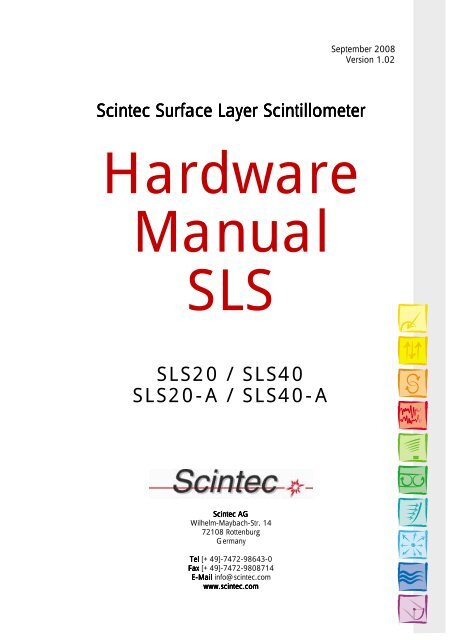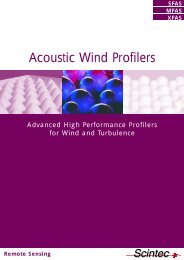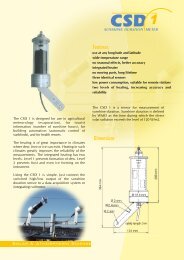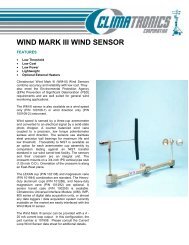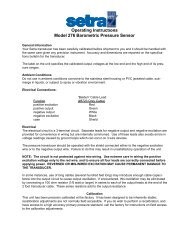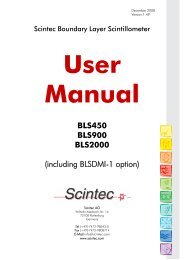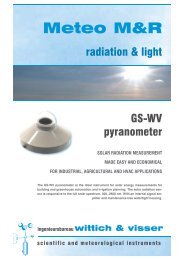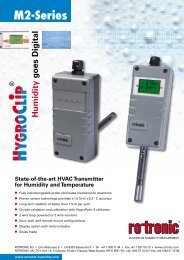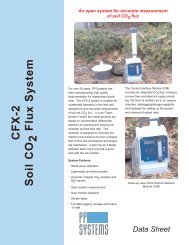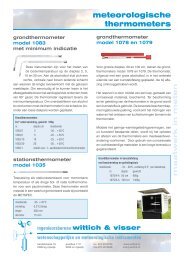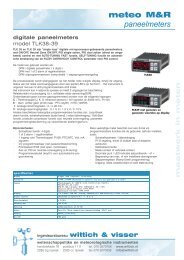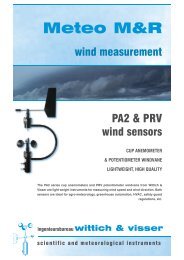Manual Hardware SLS
Manual Hardware SLS
Manual Hardware SLS
You also want an ePaper? Increase the reach of your titles
YUMPU automatically turns print PDFs into web optimized ePapers that Google loves.
September 2008<br />
Version 1.02<br />
Scintec Surface Layer Scintillometer<br />
<strong>Hardware</strong><br />
<strong>Manual</strong><br />
<strong>SLS</strong><br />
<strong>SLS</strong>20 / <strong>SLS</strong>40<br />
<strong>SLS</strong>20-A / <strong>SLS</strong>40-A<br />
Scintec AG<br />
Wilhelm-Maybach-Str. 14<br />
72108 Rottenburg<br />
Germany<br />
Tel [+49]-7472-98643-0<br />
Fax [+49]-7472-9808714<br />
E-Mail<br />
info@scintec.com<br />
www.scintec.com
Contents<br />
IMPORTANT NOTE ON LASER SAFETY CONSIDERATIONS............................ 1<br />
QUICK REFERENCE GUIDE................................................................................. 2<br />
1 INTRODUCTION................................................................................................. 3<br />
2 HARDWARE PREPARATION............................................................................. 4<br />
2.1 SELECTION OF PATH ........................................................................................... 4<br />
2.2 INSTALLING THE INSTRUMENTS............................................................................. 5<br />
2.3 ALIGNMENT......................................................................................................... 7<br />
2.4 REDUCTION IN LASER POWER............................................................................ 10<br />
APPENDIX A THEORY.................................................................................. 12<br />
APPENDIX B DESCRIPTION OF THE INSTRUMENTS ............................... 16<br />
B.1 TRANSMITTER AND RECEIVER UNITS ................................................................... 16<br />
B.1.1 General.................................................................................................... 16<br />
B.1.2 Orientation of tubes ................................................................................. 17<br />
B.1.3 Pinhole adjustment .................................................................................. 17<br />
B.1.4 Amplifier dip switch setting....................................................................... 18<br />
B.1.5 Source lifetime and operation temperature range .................................... 19<br />
B.2 JUNCTION/CONTROL BOX .................................................................................. 19<br />
B.2.1 Power supply ........................................................................................... 19<br />
B.2.2 Source control ......................................................................................... 22<br />
B.2.3 Overvoltage protection............................................................................. 22<br />
B.2.4 Connectors .............................................................................................. 23<br />
B.3 SIGNAL PROCESSING UNIT................................................................................. 25<br />
B.3.1 Power Supply........................................................................................... 26<br />
B.3.2 Connectors .............................................................................................. 26<br />
B.4 DIRECT METEOROLOGICAL INPUT <strong>SLS</strong>DMI (OPTIONAL)....................................... 29<br />
B.4.1 Overview.................................................................................................. 29<br />
B.4.2 Appliance................................................................................................. 29<br />
B.4.3 PT1000 Interface..................................................................................... 31<br />
APPENDIX C SPECIFICATIONS................................................................... 32<br />
APPENDIX D AVOIDING MEASUREMENT ERRORS .................................. 34<br />
D.1 STABILITY OF THE MOUNTING PLATFORMS ........................................................... 34<br />
D.2 LOW SIGNAL-TO-NOISE RATIO............................................................................. 34<br />
D.3 INNER SCALE MEASUREMENT RANGE .................................................................. 35<br />
D.4 CROSSTALK ...................................................................................................... 35<br />
D.5 MISALIGNMENT.................................................................................................. 36<br />
D.6 DIFFERENT INTENSITIES IN THE TWO CHANNELS .................................................. 36<br />
APPENDIX E CE DECLARATION OF CONFORMITY .................................. 37
<strong>Hardware</strong> <strong>Manual</strong> <strong>SLS</strong> 1<br />
Important Note on Laser Safety Considerations<br />
The <strong>SLS</strong>20 / <strong>SLS</strong>20-A / <strong>SLS</strong>40 / <strong>SLS</strong>40-A is a class 3a laser product.<br />
During the operation of this instrument, harmful visible laser radiation is emitted.<br />
Never look into the laser beam or at any specular reflections of the laser beam as<br />
long as you are not at a safe distance*.<br />
Never use optical instruments, in particular binoculars or telescopes, to look at the<br />
laser beam, even if you are at a safe distance for the naked eye.<br />
Attach appropriate warning signs and prevent unauthorized personnel from<br />
approaching the source.<br />
*Always be at least 50 m away from the source when looking at it from the front<br />
(see section 2.3).
<strong>Hardware</strong> <strong>Manual</strong> <strong>SLS</strong> 2<br />
Quick Reference Guide<br />
The following steps are required to perform a measurement with the <strong>SLS</strong>20(-A) /<br />
<strong>SLS</strong>40(-A):<br />
1. Install the <strong>SLS</strong> software SRun (see Software <strong>Manual</strong> SRun) and configure the<br />
software's communication parameters.<br />
2. Check the correct communication between the SPU and the PC, change the<br />
communication parameters if necessary (see Software <strong>Manual</strong> SRun)<br />
3. Setup and align the <strong>SLS</strong>20(-A) / <strong>SLS</strong>40(-A) transmitter and receiver<br />
4. Determine the background signal and crosstalk coefficients<br />
5. Start the measurement
<strong>Hardware</strong> <strong>Manual</strong> <strong>SLS</strong> 3<br />
1 Introduction<br />
The <strong>SLS</strong>20(-A) / <strong>SLS</strong>40(-A) is a sophisticated scintillometer system for accurate<br />
measurements of atmospheric turbulence. The instrument combines outstanding<br />
performance and ease-of-operation. It has the following features:<br />
− reliable laser diode source<br />
− modulated radiation for elimination of background<br />
− extremely sensitive, shot noise limited detector unit<br />
− interference filter for use in direct sunlight<br />
− operation over a single path with displaced beam technique<br />
− unaffected by turbulence inhomogeneities along the path<br />
− correction for transmitter vibrations (<strong>SLS</strong>40, <strong>SLS</strong>40-A)<br />
− automatic beam steering (<strong>SLS</strong>20-A, <strong>SLS</strong>40-A)<br />
− heated windows to prevent dew and ice deposits<br />
− path length and height user defined<br />
− rapid installation and alignment with positioning device<br />
− user-friendly software for real time data evaluation<br />
− background calibration and crosstalk correction<br />
− comprehensive error identification and correction<br />
− calculation of structure function constant<br />
refractive index fluctuations<br />
− calculation of structure function constant<br />
dissipation rate ε of kinetic energy<br />
2<br />
C<br />
n<br />
and inner scale l 0<br />
of<br />
C 2 T<br />
of temperature and<br />
− calculation of Monin-Obukhov length and turbulent fluxes of heat and<br />
momentum<br />
− screen graphics output in real time and from file<br />
− possibility of data export via Ethernet cable link<br />
− rugged weather-resistant design<br />
The <strong>SLS</strong>20 / <strong>SLS</strong>20-A / <strong>SLS</strong>40 / <strong>SLS</strong>40-A is patented under U.S. PAT. 5,303,024<br />
and DE 39 02 015 C2, others pending.
<strong>Hardware</strong> <strong>Manual</strong> <strong>SLS</strong> 4<br />
2 <strong>Hardware</strong> Preparation<br />
2.1 Selection of Path<br />
The propagation path length is defined as the distance between the centre of the<br />
transmitter and the centre of the receiver (see Fig. 1):<br />
Transmitter<br />
Receiver<br />
Path Length<br />
Figure 1: Illustration of the path length definition<br />
Operation of the <strong>SLS</strong>20(-A) / <strong>SLS</strong>40(-A) is possible over paths in the range 50 to<br />
300 m. The recommended path length is 100 to 200 m.<br />
The propagation path should be as horizontal as possible, the ground should be as<br />
even as possible. A well defined measurement height is required for application of<br />
the Monin-Obukhov similarity theory. Note that the primarily measured quantities<br />
2<br />
C<br />
n<br />
, i.e. the structure function constant of refractive index fluctuations, and 0<br />
l , i.e.<br />
the inner scale of refractive index fluctuations, strongly depend on height and a<br />
slant path would lead to an undesired averaging.<br />
The path height is defined as the height of the straight line connecting the<br />
transmitter and the receiver above ground. If the surface is not totally flat, use the<br />
average height with an increased weight at the path's centre. The path weighting<br />
functions (describing the contribution of different positions along the path) are given<br />
in Appendix A., Figs. A.1 and A.2. A typical measurement height for a path length of<br />
100 to 200 m is 1.50 to 2.00 m.<br />
When selecting the path length and height, technical and site requirements should<br />
be considered:<br />
a) The calculation of the turbulent fluxes and the Monin-Obukhov length is<br />
based on Monin-Obukhov similarity. Monin-Obukhov similarity requires the<br />
measurement height to be significantly larger than the height of the<br />
roughness elements.
<strong>Hardware</strong> <strong>Manual</strong> <strong>SLS</strong> 5<br />
b) Monin-Obukhov similarity also requires homogeneity of the site over several<br />
tens of times the measurement height upwinds. Therefore, poor site<br />
homogeneity suggests a lower measurement height.<br />
c) For long propagation paths, saturation may occur under strong turbulence<br />
conditions (see Appendix A and Appendix D). Saturation is avoided by using<br />
a sufficiently short propagation path or a large measurement height. In other<br />
words, larger path lengths suggest larger measurement heights.<br />
d) The path length changes the measurement range and sensitivity. For typical<br />
turbulence conditions, a 100 - 200 m long path provides an optimum<br />
sensitivity to the inner scale and all derived quantities.<br />
e) With short paths the intensity fluctuations are small, with long paths the<br />
average received intensity is small. Both affect the signal-to-noise ratio. A<br />
100 - 200 m path length usually provides an optimum.<br />
After you have chosen the path position and length you must:<br />
a) Enter the path length and height in the SRUN software.<br />
b) Adapt the amplifier dip switch setting in the receiver unit (see Appendix<br />
B.1.4).<br />
2.2 Installing the instruments<br />
The transmitter and receiver units must be mounted on stable platforms. The<br />
required angular pointing stability is in the order of 0.1 mrad / 1 mrad (<strong>SLS</strong>20(-A) /<br />
<strong>SLS</strong>40(-A)) at the transmitter and 1 mrad at the receiver.<br />
We recommend the use of heavy tripods used for geodetic purposes. The 5/8 inch<br />
threads at the bottoms of the instruments allow an easy connection to such<br />
devices. Strong winds (around 10 m/s or more) may require additional measures to<br />
ensure pointing stability and to avoid measurement errors caused by vibration of<br />
the transmitter (see Appendix D.1), especially with the <strong>SLS</strong>20 / <strong>SLS</strong>20-A.<br />
Before doing the alignment it is important to check:<br />
1. The source and receiver tubes must be correctly placed in the positioning<br />
devices. Verify that the rotational positions around their main axes are<br />
correct (see Appendix B.1.2). Since the two beams are identified by<br />
polarization, incorrect orientation will produce a considerable crosstalk of the<br />
signals. For the same reason make sure later that the whole instruments are<br />
correctly mounted in the horizontal.
<strong>Hardware</strong> <strong>Manual</strong> <strong>SLS</strong> 6<br />
2. After transportation or mechanical shock, the spatial filter pinhole in the<br />
transmitter unit might need repositioning (see Appendix B.1.3).<br />
Then connect the <strong>SLS</strong>20(-A) / <strong>SLS</strong>40(-A) receiver unit with the JCB. Connect the<br />
<strong>SLS</strong>20(-A) / <strong>SLS</strong>40(-A) transmitter unit with the JCB (required for auto background<br />
mode) or provide a local power supply for the transmitter unit.<br />
Connect the SPU with the Ethernet cable link to a PC or network and the<br />
Junction/Control Box (JCB) with the SPU. Supply the SPU with +12 V operation<br />
power (see Appendix B.3.1.).<br />
<strong>SLS</strong>20: Set the switch of the JCB to the "int" position.<br />
<strong>SLS</strong>20-A, <strong>SLS</strong>40, <strong>SLS</strong>40-A: With one of these systems you must connect an<br />
external 12 to 18V power supply to the Junction/Control Box (JCB), the exact<br />
voltage value depends on the cable length to the transmitter or receiver. For details<br />
see Appendix B.2.1. Set the switch at the JCB to "ext" (extern). The instrument will<br />
not work properly with the internal 12V of the SPU (switch in "int" position), except if<br />
you have a transmitter standard cable length of 150 m or less and a receiver<br />
standard cable length of 50 m or less. When the switch is in the middle position,<br />
transmitter and receiver are disconnected.<br />
Overvoltage protection:<br />
To protect the instruments against damages caused by overvoltage (atmospheric<br />
electric discharges), connect the ground connector of the JCB to a suitable ground.<br />
Note that the JCB and the SPU are not weather proved and should be kept indoors<br />
close to the PC.<br />
Weather protection:<br />
It is important to avoid cases temperatures of more than 50°C during operation. In<br />
hot and sunny climates, the instruments should therefore be operated at a naturally<br />
ventilated place or a sun protection shield should be used.<br />
The transmitter and receiver of the <strong>SLS</strong>20(-A) / <strong>SLS</strong>40(-A) withstand normal rain<br />
and snow and usually can be operated outdoors without further protection.<br />
The instruments are not totally sealed. During heavy rain, small amounts of water<br />
may penetrate into the interior of the instruments. This will not affect the operation<br />
and will dry due to natural air exchange. However, after heavy rain, do not move or<br />
shake the instruments.<br />
Measures to protect the instruments from direct precipitation are recommended for<br />
permanent installations or under severe weather conditions.
<strong>Hardware</strong> <strong>Manual</strong> <strong>SLS</strong> 7<br />
2.3 Alignment<br />
It is recommended that two persons perform the alignment, one person at the<br />
transmitter and one person at the receiver. A set of Walky-Talkies might be a<br />
helpful tool.<br />
The alignment is easiest in the following order:<br />
a) Roughly align the transmitter unit: Look through the alignment hole in the<br />
transmitter (see figure in Appendix B.1.1) and adjust the platform (tripod) until<br />
you see the receiver in the middle of the hole.<br />
Danger: The source unit emits laser radiation which is harmful for the<br />
human eye in the vicinity of the instruments. Always make sure that you<br />
are at least 50 m away from the source when looking into the beam! Never<br />
look into the beam as long as you are not behind the receiver's position!<br />
b) Roughly align the receiver unit: Look through the alignment hole in the receiver<br />
and adjust the platform (tripod) until the transmitter is in the middle of the hole.<br />
Attention: During the alignment of the transmitter and receiver, make sure that<br />
you do not tilt the platform out of the horizontal. A strictly horizontal transmitter<br />
and receiver position is required to maintain the defined polarization direction to<br />
each other. Otherwise you will later notice a considerable crosstalk.<br />
c) Make the fine adjustment of the transmitter with the three positioning screws of<br />
the positioning device. It is recommended that you first align in the vertical<br />
direction. To do this, loosen the upper screw. By turning the lower screws in the<br />
same sense, you move the beam up and down.<br />
After you have found the correct vertical position, fasten the upper screw and<br />
perform the alignment in the horizontal. To do this, turn the lower screws in an<br />
opposite sense which moves the beam to the left or to the right.<br />
The goal of the transmitter alignment is to have the receiver as close as<br />
possible to the beam's centre. When judging the beam's position one must take<br />
into account that the beam has an elliptic cross section. The optimum position<br />
of the receiver is indicated by an "O" in the following sketch (Fig. 2):
<strong>Hardware</strong> <strong>Manual</strong> <strong>SLS</strong> 8<br />
Figure 2: Illustration of the elliptic beam cross section<br />
Do the fine adjustment very carefully, especially with the <strong>SLS</strong>20 and <strong>SLS</strong>40.<br />
Usually a few iterations are required. The <strong>SLS</strong>20-A and <strong>SLS</strong>40-A will do the<br />
final fine alignment automatically, if you have configurated the software<br />
accordingly in the Automatic Alignment submenu of the Settins pull-down menu<br />
(see section 3.4.8). When you finish the alignment, make sure that the screws<br />
are properly fastened.<br />
d) To perform the receiver fine alignment, run the SRUN program and select the<br />
“Start Alignment” option in the SRun menu entry “Device”. Perform a scan-like<br />
movement of the receiver tube using the positioning screws as described<br />
above. SRun offers a graphical overview about alignment history and its current<br />
status. In the panel labelled “current”, the bars indicate the signal strengths at<br />
the two detectors. For details on the Alignment mode, see the SRun software<br />
manual.<br />
e) When you scan the receiver in the vertical and horizontal you will notice that<br />
there is a range where the signals of both channels are at maximum. The final<br />
position should be in the centre of this range (in the horizontal and in the<br />
vertical direction).<br />
Note that it is not required that the signal levels of the two channels are similar<br />
and that both channels have a slightly different field of view with a large<br />
overlapping region.<br />
f) Adapt the signal levels with the channel level regulators at the Junction/Control<br />
Box for channels 1 and 2 (with the <strong>SLS</strong>40(-A): channels 1A and 2A) until they<br />
are in the optimum range. For path lengths of 100 to 200 m, this range is<br />
marked on the screen by two horizontal lines. Turn the regulators until the<br />
averaged signals have levels in between. It is not necessary that both signals<br />
have the same level.<br />
For paths shorter than 100 m or longer than 200 m, set the levels as close as<br />
possible to the optimum range. For short paths (< 100 m), you can run the<br />
instrument with signal levels above the optimum range since the intensity
<strong>Hardware</strong> <strong>Manual</strong> <strong>SLS</strong> 9<br />
fluctuations are expected to be small then. For long paths (> 200 m), you can<br />
run the instrument with signal levels below the optimum range since large<br />
intensity fluctuations will improve the signal-to-noise ratio.<br />
If the average signals are too weak:<br />
1. Check the alignment of the transmitter.<br />
2. Check the alignment of the receiver.<br />
3. Check the pinhole adjustment at the transmitter (see Appendix B.1.3).<br />
4. Check the dip switch setting in the receiver unit (see Appendix B 1.4).<br />
5. Check if there is dirt, dew or ice deposit on the windows.<br />
If none of the above suggestions help, increase the receiver output by selecting<br />
the next higher amplifier dip switch setting in the receiver (see Appendix B.1.4).<br />
If the signals are too strong, select the next lower amplifier dip switch setting in<br />
the receiver (see Appendix B.1.4).<br />
Note that relative changes of the intensity will be evaluated. Therefore the<br />
adjustment of the signal levels only optimizes the operation and has only<br />
minor effects on the accuracy of the results.<br />
g) Measure the background signal and crosstalk coefficients by invoking the<br />
“Background Measurment” option in the SRun menu entry “Device”. You will be<br />
asked in a dialogue to first allow measurement of the undisturbed signal, then to<br />
cover the whole beam to allow measurement of the background (manual action<br />
is not necessary if the transmitter is connected to the Junction/Control Box) and<br />
then to cover the beams of channel X and channel Y separately to allow<br />
measurement of the crosstalk.<br />
The coverage of the beams must be performed directly at the beam exit of the<br />
transmitter. Use a small piece of paper which is transparent enough so you can<br />
see the position of the covered beam. Be careful to totally obscure the beam to<br />
be covered and not to touch the other beam.<br />
If the software recognizes that the beam to be covered was not perfectly<br />
covered or the other beam was touched, you will be informed and asked to<br />
repeat the procedure.<br />
After that procedure, the measured coefficients will be displayed. Check if they<br />
are ok:
<strong>Hardware</strong> <strong>Manual</strong> <strong>SLS</strong> 10<br />
The crosstalk coefficient should be below or at about 5%. If one or both of them<br />
are considerably larger, bring the transmitter and receiver in a correct horizontal<br />
position and repeat the Measure Background procedure.<br />
The background values and crosstalk coefficients determined during this<br />
procedure are used to correct the data during the measurement.<br />
Note: Alignment using a retroreflector (corner reflector)<br />
A retroreflector (corner reflector) of at least 0.2 m diameter can support a single<br />
person to do the alignment. Put the retroreflector on top of the receiver. First align<br />
the transmitter for maximum reflection which can be seen at the transmitter side<br />
very close to the transmitter. After that, verify the correct position at the receiver<br />
side and re-adjust the transmitter if necessary. Finally align the receiver as<br />
described before.<br />
2.4 Reduction in Laser Power<br />
A reduction in laser power of the transmitter might be required for very short path<br />
lengths (under about 70 m). The reduction prevents a potential saturation of the<br />
receiver, which may result in an apparent loss of received signal. To reduce the<br />
power, follow the steps given below:<br />
1. Remove the back-cover of the <strong>SLS</strong> Transmitter Unit. For this, unscrew the<br />
three Phillip head screws at the transmitter end hosting a connector with 4<br />
pins (<strong>SLS</strong>20, <strong>SLS</strong>40) or 7 pins (<strong>SLS</strong>20-A, <strong>SLS</strong>40-A). Pull out carefully the<br />
metal cylinder (see Fig. 1). The latter contains a module controlling the laser<br />
operation. Note: Do not extract the metal tube completely.<br />
Figure 1: Removing the back-cover of the <strong>SLS</strong> Transmitter Unit
<strong>Hardware</strong> <strong>Manual</strong> <strong>SLS</strong> 11<br />
2. There are three different potentiometers on the module. The furthest behind<br />
potentiometer allows a reduction in laser power (arrow in Fig. 2.).<br />
Figure 2: Identifying the appropriate potentiometer<br />
3. To reduce the power of the laser, turn the potentiometer screw counterclockwise<br />
to around 20-40% of its maximum position (default setting).<br />
Note: When changing to large path lengths, do not forget to increase the<br />
laser power to its nominal value.
<strong>Hardware</strong> <strong>Manual</strong> <strong>SLS</strong> 12<br />
Appendix A<br />
Theory<br />
If radiation of wavelength λ and wavenumber K = 2π / λ is emitted from two<br />
sources, which are separated by a distance d perpendicular to the propagation<br />
direction, and this radiation is independently observed by two detectors of diameter<br />
D, which are separated by the same distance d with the separation vectors pointing<br />
in the same direction (parallel paths), the covariance of the logarithm of the<br />
amplitude of the received radiation is given by<br />
B<br />
12<br />
= 4π<br />
² K ² ∫ dx∫<br />
0<br />
R<br />
0<br />
∞<br />
dκκφ<br />
( κ ) J<br />
n<br />
0<br />
2<br />
⎡κ<br />
² x(<br />
R − x)<br />
⎤ 4J1<br />
( κDx<br />
/ 2R)<br />
( κd<br />
)sin ² ⎢<br />
2KR<br />
⎥<br />
⎣ ⎦ ( κDx<br />
/ 2R)²<br />
, (1)<br />
where R is the propagation path length, x is the coordinate along the propagation<br />
path, φ<br />
n<br />
is the three-dimensional spectrum of the refractive index inhomogeneities<br />
and J<br />
0<br />
and J 1<br />
are Bessel functions of the first kind. Eq. (1) is valid as long as<br />
scattering is weak, i. e. as long as B 12<br />
< 0.3. Otherwise saturation occurs. In this<br />
case the measured B<br />
12<br />
is smaller than that predicted by Eq. (1).<br />
Withd = 0 , Eq. (1) also provides the expression for the variances B<br />
1<br />
and B<br />
2<br />
at the<br />
single detectors.<br />
The inner integral of Eq. (1) is the path weighting function. The path weighting<br />
functions of the variances and covariances for a 100 m propagation distance and<br />
values of the inner scale l 0<br />
of 2mm, 4mm and 10mm are given in Figs. A.1 and<br />
A.2.<br />
Figure A.1: Path weigthing functions (100 m path)
<strong>Hardware</strong> <strong>Manual</strong> <strong>SLS</strong> 13<br />
Figure A.2: Path weigthing functions (100 m path)<br />
The function φ<br />
n<br />
has the form<br />
φ<br />
n<br />
( C n φ 0<br />
2 − 3<br />
κ)<br />
= 0.033 κ<br />
11 / f ( κl ) , (2)<br />
2<br />
where C<br />
n<br />
is the structure function constant of refractive index in the inertial<br />
subrange of turbulence and f φ<br />
( κ l 0<br />
) is a function describing the decay of refractive<br />
index fluctuations in the dissipation range. The model of Hill is assumed for f φ<br />
.<br />
2<br />
Inserting Eq. (2) into Eq. (1) defines the covariance and the variances if C<br />
n<br />
, l<br />
0<br />
and<br />
the physical dimensions of the instrument are known. Hence measurements of B<br />
12<br />
and B<br />
1<br />
or B<br />
2<br />
can be used to derive C 2 n<br />
and l<br />
0<br />
. Note that the correlation coefficient<br />
1/ 2<br />
r = B12 /( B1B2<br />
) = B12<br />
/ B1<br />
= B12<br />
/ B2<br />
is a function of l 0<br />
only. For a 100 m long path<br />
this relationship is given in Fig. A.3.<br />
Figure A.3: Correlation versus inner scale l<br />
0<br />
Note also that the variances B 1<br />
and B 2<br />
are not only proportional toC 2 n<br />
, but they also
<strong>Hardware</strong> <strong>Manual</strong> <strong>SLS</strong> 14<br />
depend on l<br />
0<br />
.<br />
Since variances of intensityσ<br />
2<br />
i<br />
are measured rather than variances of log-amplitude<br />
2<br />
B<br />
i<br />
, σ<br />
i<br />
must be converted into B i<br />
. For log-normally distributed amplitude one can<br />
apply the relation<br />
B<br />
i<br />
2<br />
1 ⎛ σ ⎞<br />
= ⎜ ⎟<br />
+<br />
i<br />
log 1 . (3)<br />
4<br />
⎝ I<br />
i<br />
² ⎠<br />
FromC the structure function constant of temperature<br />
2 n<br />
2<br />
C<br />
T<br />
can be calculated via<br />
CT , (4)<br />
2 = C<br />
2 T ap<br />
−<br />
n<br />
4 ( ) 2<br />
where T is the air temperature in Kelvin and p is the air pressure in hPa (mbar).<br />
−5<br />
The constant a is given by 7.89 ⋅ 10 K/hPa at 670 nm wavelength.<br />
Eq. (4) neglects the contribution of humidity fluctuations. In the presence of<br />
humidity fluctuations a small error occurs. By use of similarity arguments, the error<br />
of C<br />
T<br />
(and that of the later derived heat fluxes) can be estimated to be 3% times<br />
the inverse Bowen ratio (latent heat flux divided by sensible heat flux). Note that the<br />
error is quite exactly half as large as the humidity error of ultrasonic thermometers.<br />
The inner scale l<br />
0<br />
is closely related to the dissipation rate of the kinetic energy of<br />
turbulence ε:<br />
( 7.4 / l ) 4<br />
3<br />
ε = ν<br />
0<br />
. (5)<br />
Here ν is the kinematic viscosity of air which can be calculated in m²/s via<br />
1 −5<br />
ν = [1.718 + 0.0049( T − 273.15)] ρ<br />
− ⋅10<br />
, (6)<br />
if T is the temperature in K and ρ is the air density in kg/m³.<br />
FromC 2 T<br />
and ε, the turbulent kinematic fluxes of heat Q 0<br />
(unit K m/s) and<br />
2<br />
momentum − u<br />
∗<br />
(unit m²/s²) can be computed by use of Monin-Obukhov similarity.<br />
If T* = −Q0<br />
/ u*<br />
is the turbulent temperature scale, L = T* u²<br />
*<br />
/( kgT*<br />
) is the Monin-<br />
Obukhov length, z is the height above ground, k = 0.4 is the von Karman constant,<br />
g = 9.81 m/s² is the gravitational acceleration, and β<br />
1<br />
= 0.86 is the Obukhov-Corrsin<br />
constant, then the following semi-empirical expressions have proven a quite high<br />
accuracy:<br />
2<br />
−1/<br />
3<br />
⎛<br />
⎞<br />
2 2 / 3 −2<br />
( )<br />
*<br />
4 ⎜<br />
z ⎛ z ⎞<br />
C T<br />
kz T = β<br />
1<br />
1−<br />
7 + 75⎜<br />
⎟ ⎟<br />
(7)<br />
⎜<br />
⎝<br />
L<br />
⎝ L ⎠<br />
⎟<br />
⎠
<strong>Hardware</strong> <strong>Manual</strong> <strong>SLS</strong> 15<br />
and<br />
−1<br />
=<br />
−3<br />
⎛ z ⎞ z<br />
ε kzu* ⎜1<br />
− 3 ⎟ −<br />
(8)<br />
⎝ L ⎠ L<br />
for z L < 0 (unstable), and<br />
2<br />
1/ 3<br />
⎛<br />
⎞<br />
2 2 / 3 −2<br />
( )<br />
*<br />
4 ⎜<br />
z ⎛ z ⎞<br />
C T<br />
kz T = β<br />
1<br />
1+<br />
7 + 20⎜<br />
⎟ ⎟<br />
(9)<br />
and<br />
⎜<br />
⎝<br />
L<br />
⎝ L ⎠<br />
⎟<br />
⎠<br />
−1/<br />
2<br />
2<br />
⎛<br />
⎞<br />
−3<br />
⎜<br />
z ⎛ z ⎞<br />
ε kzu* = 1+<br />
4 + 16 ⎟<br />
⎜ ⎟<br />
(10)<br />
⎝ L ⎝ L ⎠ ⎠<br />
for z L > 0 (stable).<br />
Solving equations (7), (8), (9) and (10) for the turbulent fluxes requires a numerical<br />
iteration scheme.<br />
The turbulent heat flux H with unit W/m² and the turbulent momentum flux M with<br />
unit kg m −1<br />
s −2<br />
are calculated via the relations<br />
H<br />
= − c u T * *<br />
(11)<br />
p<br />
ρ<br />
and<br />
M ρu *<br />
2<br />
= − . (12)
<strong>Hardware</strong> <strong>Manual</strong> <strong>SLS</strong> 16<br />
Appendix B<br />
Description of the instruments<br />
B.1 Transmitter and receiver units<br />
B.1.1 General<br />
The transmitter and receiver units consist of the tubes and the positioning devices.<br />
The tubes contain optics and electronics.<br />
The electronics in the transmitter unit produces the modulation signal. Hence it<br />
requires only DC voltage for operation.<br />
The electronics in the receiver unit consists of signal amplifiers and voltage<br />
regulators. The modulated signals are then transferred through the line to the<br />
Junction/Control Box and further to the Signal Processing Unit (SPU).<br />
Both, transmitter and receiver have a heatable front glass to prevent ice or dew<br />
deposits (see Appendix B.2.1).<br />
Do not open the transmitter or the receiver tubes since they will be difficult to readjust.<br />
An exception is the back-cover of the receiver, which must be opened to<br />
change the amplifier dip switch setting (see section B.1.4).<br />
The only necessary maintenance to be performed by the user is the pinhole<br />
adjustment (see section B.1.3). Additionally, the user should regularly check the<br />
orientation of the tubes (see section B.1.2).<br />
Figure B.1: <strong>SLS</strong>20 Transmitter Unit
<strong>Hardware</strong> <strong>Manual</strong> <strong>SLS</strong> 17<br />
B.1.2 Orientation of tubes<br />
Since the two beams are identified by their polarization direction, the orientation of<br />
the transmitter and receiver relative to each other must be coordinated. Therefore it<br />
is necessary that the tubes have the correct rotational orientation within the<br />
positioning devices. Make sure also that the units are well horizontally positioned<br />
during the operation. Otherwise a noticeable crosstalk between the two channels<br />
will be noticed (more than a few percent).<br />
The correct orientations of the tubes within the positioning devices are as follows:<br />
Transmitter: The source emits two beams. These two beams must lie exactly in a<br />
horizontal line. Check with a (sufficiently transparent) piece of paper covering the<br />
frontal window. If necessary, open the positioning screws and turn the tube until the<br />
position is correct.<br />
It is also required that the "down" mark on the tube (black triangle on red ground)<br />
shows downwards. If the down mark of the transmitter shows upwards and that of<br />
the receiver shows downwards (or inverse), crossed paths (instead of parallel<br />
paths) would result and will produce wrong data.<br />
Receiver: Near the back of the receiver tube there is a small screw near the "down"<br />
mark. This screw must exactly show down.<br />
B.1.3 Pinhole adjustment<br />
After transportation, mechanical shock or strong temperature variations it might be<br />
necessary to re-adjust the spatial filter pinhole in the transmitter unit. It is<br />
recommended that a re-adjustment is made every time the instruments have been<br />
moved before the measurements start.<br />
The three (small) pinhole adjustment screws are near the front end of the<br />
transmitter tube (see figure on the page before). Use two small screw drivers to<br />
perform the adjustment procedure as follows:<br />
a) Put a screen (piece of paper) in front of the instrument or point the laser beam to<br />
a white wall. Operate the laser, you will see two red spots (these spots overlap in a<br />
short distance).<br />
b) Loosen one of the pinhole adjustment screws a little (less than a quarter turn)<br />
and immediately follow with another screw by turning it in the opposite sense<br />
(tightening direction). You will notice the beam becoming more or less bright.<br />
Maximize the output intensity.<br />
c) Repeat this procedure iteratively with two other screws, always trying to achieve<br />
the maximum beam output, until no further improvement is possible.
<strong>Hardware</strong> <strong>Manual</strong> <strong>SLS</strong> 18<br />
Caution: 1. Be very careful to never "lose" the beam. It is quite difficult to find<br />
it again. 2. Never loosen a screw without at the same time tightening another<br />
screw. The pinhole is fixed by the adjustment screws and may otherwise drop<br />
out.<br />
d) Tighten the pinhole by tightening one screw.<br />
B.1.4 Amplifier dip switch setting<br />
The <strong>SLS</strong>20(-A) / <strong>SLS</strong>40(-A) can be operated over different path lengths. Different<br />
path lengths go along with different radiation intensities. The dip switches in the<br />
back of the receiver tube allow the adaptation of the voltage output range.<br />
In order to reach the dip switches, unplug the receiver, turn out the three Phillips<br />
screws at the back and carefully pull off the back cover. Be cautious not to tear off<br />
one of the cables. The dip switch is now visible.<br />
<strong>SLS</strong>20(-A): The first 4 dip switches (1-4) belong to channel 1 and the second 4 dip<br />
switches (5-8) belong to channel 2.<br />
<strong>SLS</strong>40(-A): The first 4 dip switches (1-4) of the upper row belong to channel 1A and<br />
the second 4 dip switches (5-8) of the upper row belong to channel 2A. The first 4<br />
dip switches (1-4) of the lower row belong to channel 1B and the second 4 dip<br />
switches (5-8) of the lower row belong to channel 2B.<br />
If "0" means position "off" (up) and "1" means position "on" (down) then the<br />
following dip switch positions typically correspond to the following ranges:<br />
Switch 1 2 3 4 5 6 7 8 Path Length<br />
0 0 0 1 0 0 0 1 < 100 m (see Note)<br />
1 1 1 0 1 1 1 0<br />
90 – 120 m<br />
(factory setting)<br />
Position 0 0 1 0 0 0 1 0 110 – 150 m<br />
1 1 0 0 1 1 0 0 140 – 190 m<br />
0 1 0 0 0 1 0 0 170 – 220 m<br />
1 0 0 0 1 0 0 0 210 – 300 m<br />
Note: For paths much shorter than 100 m, the mean level may be higher than the<br />
indicated range. If the fluctuating signal does not hit the upper range limit (4095<br />
digits), this can be tolerated. If regularly hits or even continuously is at the upper<br />
range limit and you cannot make the path longer, the laser output power should be<br />
reduced.
<strong>Hardware</strong> <strong>Manual</strong> <strong>SLS</strong> 19<br />
If for a well aligned set-up, the signal is too low or too high (and cannot be adjusted<br />
at the Junction/Control Box), use the next lower or higher dip switch setting,<br />
respectively. With the <strong>SLS</strong>40(-A), the dip switch settings of the upper and lower row<br />
usually is identical.<br />
B.1.5 Source lifetime and operation temperature range<br />
The <strong>SLS</strong>20(-A) / <strong>SLS</strong>40(-A) uses laser diodes as radiation sources which typically<br />
operate over more than 20.000 hours.<br />
Laser diodes will be damaged or their lifetime will be decreased if they are operated<br />
at unfavourate temperatures. Therefore never operate the transmitter outside its<br />
given operation temperature range (see specifications in Appendix C). Make sure<br />
that the instrument is shielded from direct sun radiation on hot days. Also do not<br />
unattendedly operate the instrument when the temperature may drop below the<br />
lower temperature limit.<br />
A damaged source emits a significantly reduced light intensity. In this case send the<br />
transmitter unit to the manufacturer for source replacement.<br />
B.2 Junction/Control Box<br />
The Junction/Control Box is an interface for connecting the transmitter and the<br />
receiver to the SPU. Depending on the lengths of the cables to the transmitter and<br />
receiver, an external power supply might be hooked up to the Junction/Control Box.<br />
B.2.1 Power supply<br />
If supply by the SPU is desired put the switch at the JCB to the "int" position.<br />
Otherwise put the switch to the "ext" position and connect the external power<br />
supply using the corresponding Junction/Control Box power supply cable. If the<br />
switch is in the middle position, both source and receiver are disconnected.<br />
With the <strong>SLS</strong>20-A, <strong>SLS</strong>40 and <strong>SLS</strong>40-A, power supply by the SPU is only possible<br />
if the cables to the receiver or transmitter do not exceed the following lengths:<br />
<strong>SLS</strong>20-A<br />
<strong>SLS</strong>40<br />
<strong>SLS</strong>40-A<br />
cable to transmitter - 150 m<br />
cable to receiver - 50 m<br />
cable to transmitter - 150 m and cable to receiver - 50 m<br />
If the cable length to the transmitter and/or receiver exceeds the cable lengths<br />
given above, an external power supply is required.
<strong>Hardware</strong> <strong>Manual</strong> <strong>SLS</strong> 20<br />
The external power supply must provide currents of<br />
<strong>SLS</strong>20<br />
<strong>SLS</strong>20-A<br />
<strong>SLS</strong>40<br />
<strong>SLS</strong>40-A<br />
100 mA at +12 V<br />
50 mA at -12 V<br />
500 mA at +12 to -18 V (required voltage, see below)<br />
150 mA at -12 to -18 V (required voltage, see below)<br />
350 mA at +12 to +18 V<br />
200 mA at -12 to -18 V<br />
550 mA at +12 to +18 V<br />
200 mA at -12 to -18 V<br />
For external supply, the following operation voltages are required:<br />
Model Cable Lengths Operation Voltage<br />
<strong>SLS</strong>20 Up to 400 m to transmitter and<br />
up to 200 m to receiver<br />
±12 V (18 V max.)<br />
<strong>SLS</strong>20-A Up to 150 m to transmitter and<br />
up to 200 m to receiver<br />
±12 V (13.5 V max.)<br />
150 – 300 m to transmitter and<br />
up to 200 m to receiver<br />
±16 V (17.6 V max.)<br />
300 – 400 m to transmitter and<br />
up to 200 m to receiver<br />
±18 V (19.8 V max.)<br />
<strong>SLS</strong>40 Up to 400 m to transmitter and<br />
up to 50 m to receiver<br />
±12 V (18 V max.)<br />
Up to 400 m to transmitter and<br />
up 50 – 150 m to receiver<br />
±16 V (18 V max.)<br />
Up to 400 m to transmitter and<br />
up 150 – 200 m to receiver<br />
±18 V (19.6 V max.)<br />
<strong>SLS</strong>40-A Up to 150 m to transmitter and<br />
up to 50 m to receiver<br />
±12 V (13.5 V max.)<br />
150 – 300 m to transmitter and<br />
up to 50 m to receiver<br />
±16 V (17.6 V max.)<br />
300 – 400 m to transmitter and<br />
up to 50 m to receiver<br />
±18 V (19.8 V max.)<br />
Up to 150 m to transmitter and<br />
50 – 150 m to receiver<br />
±16 V (17.6 V max.)<br />
Attention: Set JCB Power Supply<br />
Jumper to “on” (see below)<br />
150 – 300 m to transmitter and<br />
50 – 150 m to receiver<br />
±16 V (17.6 V max.)<br />
300 – 400 m to transmitter and<br />
±18 V (19.8 V max.)<br />
50 – 150 m to receiver<br />
Up to 150 m to transmitter and<br />
150 – 200 m to receiver<br />
150 – 400 m to transmitter and<br />
150 – 200 m to receiver<br />
±18 V (19.8 V max.)<br />
Attention: Set JCB Power Supply<br />
Jumper to “on” (see below)<br />
±18 V (19.8 V max.)
<strong>Hardware</strong> <strong>Manual</strong> <strong>SLS</strong> 21<br />
In the certain cases indicated above, the JCB Power Supply Jumper must be set to<br />
"on", otherwise it must be set to "off" (default). This is necessary to avoid a too high<br />
voltage at the transmitter in cases of a short transmitter cable and a long receiver<br />
cable.<br />
To access the Power Supply Jumper, open the Junction/Control Box. The jumper<br />
position is defined in the following drawing:<br />
If the transmitter is fed locally (e.g. by battery with a short supply cable), the<br />
transmitter output at the Junction/Control Box remains unconnected (only for<br />
<strong>SLS</strong>20 and <strong>SLS</strong>40, no "auto background" is possible then).
<strong>Hardware</strong> <strong>Manual</strong> <strong>SLS</strong> 22<br />
In order to heat the front windows of the <strong>SLS</strong>20 transmitter and receiver, connect<br />
12V DC or AC (200 mA) to the respective inputs at the JCB. The windows will be<br />
heated to prevent ice and dew deposits under certain weather conditions.<br />
The window of the <strong>SLS</strong>20-A, <strong>SLS</strong>40 and <strong>SLS</strong>40-A transmitter and receiver are<br />
always heated since the heating is connected to the general supply voltage.<br />
B.2.2 Source control<br />
The transmitter is controlled by an electronic switch in the JCB. The LED on the top<br />
of the JCB is illuminated if this switch is "on". "LED on" does not automatically<br />
mean that the source is powered on. This additionally requires an internal or<br />
external power supply and the switch being in "int" or "ext" position.<br />
B.2.3 Overvoltage protection<br />
In order to lower the sensitivity of the system to electrical discharges in the<br />
atmosphere, the JCB contains an overvoltage protection circuit. This requires<br />
connection of the ground connector at the case with a suitable ground.
<strong>Hardware</strong> <strong>Manual</strong> <strong>SLS</strong> 23<br />
B.2.4 Connectors<br />
(I) Connectors at the Junction/Control Box (JCB)
<strong>Hardware</strong> <strong>Manual</strong> <strong>SLS</strong> 24<br />
(II) Connectors at the Junction/Control Box (JCB)<br />
Color code of supplied power supply connection cable:<br />
red: pos. supply voltage + 12-18 V (to pin 1)<br />
blue: neg. supply voltage - 12-18 V (to pin 2)<br />
black: ground, 0 V (to pin 5)<br />
yellow: window heating (<strong>SLS</strong>20 only) (to pin 3)<br />
yellow: window heating (<strong>SLS</strong>20 only) (to pin 4)
<strong>Hardware</strong> <strong>Manual</strong> <strong>SLS</strong> 25<br />
B.3 Signal Processing Unit (SPU)<br />
The SPU is equipped with three LEDs. They give information about the following<br />
system properties:<br />
Power<br />
LED lights on green when proper voltage is applied to the<br />
system<br />
Status<br />
LED lights on yellow as follows:<br />
− The status LED blinks with a period of 2 seconds after<br />
having powered on the <strong>SLS</strong> system. The system is<br />
now ready for starting a measurement<br />
− In measurement mode, the LED is continuously<br />
illuminated with short interrupts every second. This<br />
indicates a 90% duty cycle.<br />
Error<br />
The SPU is equipped with a voltage monitoring system. In<br />
case of a voltage drop, the LED lights on red.<br />
The overall configuration of the LEDs as well as connectors on the SPU front side<br />
is illustrated in the follwing figure:<br />
Pressure<br />
Ethernet<br />
Temperature<br />
Weather Station IN/RS232<br />
Power<br />
Status<br />
Error<br />
Power Supply<br />
Weather Station Out/RS232<br />
Junction/Control Box
<strong>Hardware</strong> <strong>Manual</strong> <strong>SLS</strong> 26<br />
B.3.1 Power Supply<br />
The Signal Processing Unit (SPU) generates the 12V DC voltages needed for the<br />
<strong>SLS</strong> transmitter and receiver from an external power supply. For this, a single 12 V<br />
supply voltage with a peak current capability of around 2 A is required. Connection<br />
between the power source and the SPU is established via the supplied battery<br />
power supply cable having the following color code:<br />
red cable: supply voltage +12 V (max 13.8 V, 2 A peak)<br />
black cable: supply voltage ground<br />
With the <strong>SLS</strong>20, the voltage for the window heating of transmitter and receiver<br />
(prevention of ice and dew deposits) must be connected to the JCB (see Appendix<br />
B.2.1). This can be the same voltage as used for the SPU.<br />
B.3.2 Connectors<br />
The standard <strong>SLS</strong> SPU is equipped with the following connectors:<br />
−<br />
−<br />
−<br />
−<br />
−<br />
Power Supply<br />
Ethernet<br />
Junction/Control Box<br />
Weather Station In/RS232<br />
Weather Station Out/RS232<br />
With optional available <strong>SLS</strong>DMI-1 or <strong>SLS</strong>DMI-2 sensors, two additional connectors<br />
can be found on the front side of the SPU:<br />
−<br />
−<br />
Pressure<br />
Temperature<br />
The following table gives an overview about all pin connection schemes:
<strong>Hardware</strong> <strong>Manual</strong> <strong>SLS</strong> 27<br />
Male Connector:<br />
Power Supply<br />
Function<br />
Pin<br />
+12 VDC A<br />
+12 VDC B<br />
GND<br />
C<br />
GND<br />
D<br />
D<br />
C<br />
A<br />
B<br />
Male Connector:<br />
Junction/Control Box<br />
Function<br />
Pin<br />
-12V DC 1<br />
+12V DC 2<br />
GND 3<br />
Signal XA 4<br />
Signal YA 5<br />
Signal XB 6<br />
Signal YB 7<br />
Not connected 8<br />
Laser On 9<br />
1 2 3<br />
8 9 4<br />
7<br />
6 5<br />
Male Connector:<br />
Ethernet<br />
Function<br />
Pin<br />
Signal TX- 1<br />
Signal TX+ 2<br />
Signal RX- 3<br />
Signal RX+ 4<br />
Not connected 5<br />
Not connected 6<br />
Not connected 7<br />
1 2 3<br />
6 7 4<br />
5
<strong>Hardware</strong> <strong>Manual</strong> <strong>SLS</strong> 28<br />
Female Connectors:<br />
Weather Station In/RS232<br />
Weather Station Out/RS232<br />
Function<br />
Pin<br />
GND 1<br />
Signal RX 2<br />
Signal TX 3<br />
+12V DC 4<br />
+12V DC RS485 5<br />
GND RS485 6<br />
GND 7<br />
5<br />
6 4 7<br />
1 3 2<br />
Female Connector:<br />
Pressure<br />
Function<br />
Pin<br />
+12V DC 1<br />
GND 2<br />
Signal Pressure 3<br />
Not connected 4<br />
4<br />
3<br />
1 2<br />
Female Connector:<br />
Temperature<br />
Function<br />
Pin<br />
+12V DC 1<br />
GND 2<br />
Signal Temperature 1 3<br />
Signal Temperature 2 4<br />
4<br />
3<br />
1 2
<strong>Hardware</strong> <strong>Manual</strong> <strong>SLS</strong> 29<br />
B.4 Direct Meteorological Input <strong>SLS</strong>DMI (Optional)<br />
B.4.1 Overview<br />
The <strong>SLS</strong>DMI-1 option consists of a temperature sensor, a barometric pressure<br />
sensor, a small tower and cables to connect the sensors to the SPU. The sensors<br />
measure continuously air pressure and temperature and the software uses these<br />
measured parameters in real-time.<br />
The PT1000 temperature sensor is plugged into a ventilated radiation shield which<br />
can be installed on the tower. The radiation shield avoids measurement errors due<br />
to sun radiation. The PT1000 is connected to a <strong>SLS</strong>DMI sensor interface which<br />
converts the PT1000 resistance into a voltage. The barometric pressure sensor<br />
includes a voltage output which is connected directly to the SPU.<br />
B.4.2 Appliance<br />
The temperature sensor can be fixed on the tower, and should be located next to<br />
the measurement range to account for accurate results. The cable between the<br />
temperature sensor interface and the SPU is 10m as standard.<br />
The DC power for the sensor interface is supplied via cable from the SPU. The AC<br />
power for the shield aspiration must be provided next to the tower. The pressure<br />
sensor is delivered with a 5 m cable and can be fixed next to the SPU. The DC<br />
power for the pressure sensor is supplied via cable from the SPU.<br />
The SPU includes two additional connectors for temperature and pressure. An<br />
electrical connection scheme of the <strong>SLS</strong>DMI-1 option is shown in the following<br />
figure:
<strong>Hardware</strong> <strong>Manual</strong> <strong>SLS</strong> 30
<strong>Hardware</strong> <strong>Manual</strong> <strong>SLS</strong> 31<br />
B.4.3 PT1000 Interface<br />
The Temperature Sensor Interface <strong>SLS</strong>DMI-1 / <strong>SLS</strong>DMI-2 converts the resistance<br />
of two PT1000 Platinum temperature sensors into two output voltages 0 to 10 V<br />
corresponding to a temperature range of -50 to +50°C.<br />
Connection scheme:<br />
V+ +12 to +15 V supply voltage<br />
GND<br />
supply and output ground<br />
+SENSE1 voltage out sensor 1, positive<br />
+RTD1<br />
current sensor 1, positive<br />
-RTD1<br />
current sensor 1, negative<br />
-SENSE1 voltage out sensor 1, negative<br />
+SENSE2 voltage out sensor 2, positive<br />
+RTD2<br />
current sensor 2, positive<br />
-RTD2<br />
current sensor 2, negative<br />
-SENSE2 voltage out sensor 2, negative<br />
OUT1 output voltage or current sensor 1<br />
OUT2 output voltage or current sensor 2<br />
Jumper positions:<br />
Jumpers 1-4<br />
upper position: voltage output<br />
lower position: current output<br />
(The 4-20 mA current output is optionally available for lines of more than 300 m<br />
length.)
<strong>Hardware</strong> <strong>Manual</strong> <strong>SLS</strong> 32<br />
Appendix C<br />
Specifications<br />
General:<br />
source:<br />
laser diode<br />
wavelength:<br />
670 nm±10 nm<br />
lifetime:<br />
20 000 hours typically<br />
beam collimation:<br />
by 3 lenses<br />
beam divergence:<br />
10 mrad x 3.5 mrad<br />
scan cone radius:<br />
1° (<strong>SLS</strong>20-A and <strong>SLS</strong>40-A only)<br />
beam output power:<br />
1 mW mean, 2 mW peak<br />
modulation frequency:<br />
20 kHz<br />
modulation depth: 90%<br />
beam displacement:<br />
2.7 mm<br />
number of detectors:<br />
2 (<strong>SLS</strong>20 and <strong>SLS</strong>20-A)<br />
4 (<strong>SLS</strong>40 and <strong>SLS</strong>40-A)<br />
detector separation:<br />
2.7 mm<br />
detector diameter:<br />
2.5 mm<br />
receiver bandwidth:<br />
4 kHz<br />
Supply Voltages and Currents:<br />
transmitter <strong>SLS</strong>20<br />
window heating<br />
transmitter <strong>SLS</strong>40<br />
transmitter <strong>SLS</strong>20-A / <strong>SLS</strong>40-A<br />
receiver <strong>SLS</strong>20<br />
window heating<br />
receiver <strong>SLS</strong>20-A<br />
receiver <strong>SLS</strong>40 / <strong>SLS</strong>40-A<br />
+12 V 0.05 A<br />
12 V 0.1 A<br />
+12 V 0.15 A<br />
(including window heating)<br />
+12 V 0.35 A<br />
(including window heating)<br />
+12 V 0.05 A -12 V 0.05 A<br />
12 V 0.1 A<br />
+12 V 0.15 A -12 V 0.15 A<br />
(including window heating)<br />
+12 V 0.2 A -12 V 0.2 A<br />
(including window heating)<br />
A larger voltage must be supplied at the remote cable end to allow for voltage drop<br />
over the cable (see table in Appendix B.2.1).<br />
SPU<br />
+12 V 0.7 A for <strong>SLS</strong>20(-A), peak 1.5 A<br />
+12 V 1.4 A for <strong>SLS</strong>40(-A), peak 2.0 A
<strong>Hardware</strong> <strong>Manual</strong> <strong>SLS</strong> 33<br />
Temperature Ranges:<br />
Transmitter<br />
Receiver<br />
JCB<br />
SPU<br />
-20°C to 50°C operation<br />
-40°C to 60°C storage<br />
-25°C to 60°C operation<br />
-40°C to 60°C storage<br />
-25°C to 50°C operation<br />
-40°C to 60°C storage<br />
-20°C to 40°C operation<br />
-40°C to 60°C storage<br />
Dimensions and Weights:<br />
<strong>SLS</strong>20/<strong>SLS</strong>40 transmitter<br />
<strong>SLS</strong>20-A/<strong>SLS</strong>40-A transmitter<br />
<strong>SLS</strong>20/<strong>SLS</strong>20-A receiver<br />
<strong>SLS</strong>40/<strong>SLS</strong>40-A receiver<br />
JCB <strong>SLS</strong>20<br />
JCB <strong>SLS</strong>40<br />
SPU<br />
0.65 m x 0.11 m x 0.11 m, 3.0 kg<br />
0.70 m x 0.11 m x 0.11 m, 3.5 kg<br />
0.60 m x 0.11 m x 0.11 m, 2.9 kg<br />
0.62 m x 0.12 m x 0.12 m, 4.1 kg<br />
0.14 m x 0.12 m x 0.06 m, 0.4 kg<br />
0.22 m x 0.19 m x 0.10 m, 1.8 kg<br />
0.25 m x 0.22 m x 0.19 m, 5.5 kg
<strong>Hardware</strong> <strong>Manual</strong> <strong>SLS</strong> 34<br />
Appendix D<br />
Avoiding measurement errors<br />
D.1 Stability of the mounting platforms<br />
Wind induced mechanical vibrations of the instruments, in particular of the <strong>SLS</strong>20(-<br />
A) transmitter, may seriously affect the measurements. Since this error cannot be<br />
corrected for later, always verify that the transmitter and the receiver are stably<br />
mounted.<br />
Instabilities of the mountings affect the measurement as follows: A vibration (mainly<br />
a twist) of the transmitter causes a wander of the laser beams at the receiver and<br />
hence produces a variation of the measured intensities. This intensity variation is<br />
2<br />
added to the turbulent intensity fluctuations. The calculated values of C<br />
n<br />
will be too<br />
high, the calculated l 0<br />
will be too low or too high. This causes errors in the heat and<br />
(even more pronounced) in the momentum flux. Note that stability problems<br />
2<br />
generally are more important when the turbulent intensity fluctuations (orC n<br />
) are<br />
small.<br />
The <strong>SLS</strong>40(-A) receiver has a separate pair of detectors which allows automatic<br />
identification of and correction for the transmitter vibrations by the <strong>SLS</strong>RUN<br />
software. However also the <strong>SLS</strong>40(-A) transmitter should be mounted as stable as<br />
possible.<br />
In principle, a vibration of the receiver may have a similar effect. However, since the<br />
field of view of the receiver is much larger than the beam's divergence, the stability<br />
of the receiver mounting is much less critical.<br />
As a rule of thumb, the <strong>SLS</strong>20(-A) is affected by vibrations having such a<br />
magnitude that you can feel them with your hands at the transmitter. If you cannot<br />
improve the mounting (e.g. if you use tripods), apply a wind shield mounted<br />
upwinds to the transmitter tripod.<br />
In order to test the stability of the mountings, you may also try to move and twist the<br />
instruments with your hands. Estimate the wind force acting: This force must not<br />
move the instruments. Take into account that already a fraction of<br />
1 mrad (0.05 degrees) twist of the transmitter has an effect.<br />
D.2 Low signal - to - noise ratio<br />
The <strong>SLS</strong>RUN software displays an error message if the signal-to-noise ratio is<br />
unacceptable. Marginal cases pass the software test and may cause errors of a<br />
limited extend.<br />
A low signal-to-noise ratio means that a significant amount of noise is added to the<br />
turbulent signal fluctuations. This noise is uncorrelated in both channels. Hence it
<strong>Hardware</strong> <strong>Manual</strong> <strong>SLS</strong> 35<br />
tends to increase the calculatedC 2 n<br />
and decrease the calculated l<br />
0<br />
values.<br />
Accordingly the calculated heat and momentum fluxes will be too high.<br />
Signal-to-noise problems only occur when<br />
measurement limit. They rapidly become negligible as<br />
2<br />
C<br />
n<br />
is very small, i.e. near the<br />
2<br />
C<br />
n<br />
increases. Since small<br />
2<br />
C<br />
n<br />
values go along with small heat fluxes, possibly affected periods in heat flux<br />
time series are easily identified. The affected periods typically last several minutes<br />
until the heat flux (absolute value) has increased.<br />
With the <strong>SLS</strong>20(-A)/ <strong>SLS</strong>40(-A), signal-to-noise limitations are rare. If observed,<br />
they are mainly due to transmitter vibrations (see above). They may also have<br />
some importance under special measurement conditions, e.g. if measurements are<br />
taken over water or under weather conditions which are connected with small heat<br />
fluxes (absolute values).<br />
You improve the signal-to-noise ratio by<br />
a. shortening the path if it is longer than 200 m or lengthening the path if it is<br />
shorter than 100 m<br />
b. lowering the measurement height if the surface roughness and your<br />
measurement task allows.<br />
D.3 Inner scale measurement range<br />
There is a lower limit of the l 0<br />
values which can be accurately determined by the<br />
<strong>SLS</strong>20(-A) / <strong>SLS</strong>40(-A). If l 0<br />
falls below this limit, the instrument is susceptible to<br />
measurement errors.<br />
The lower l 0<br />
limit depends on the path length. It is 2 mm for paths of 100 m or<br />
longer, 2.5 mm for a path of 80 m, and 3.5 mm for a path of 50 m. If small l 0<br />
values are to be measured, it is therefore advisable to use a minimum path length<br />
of 100 m.<br />
Note that l 0<br />
becomes smaller at larger wind speeds or closer to the ground. The<br />
height dependence of l<br />
0<br />
may allow you to adapt the height of the path to the given<br />
measurement range.<br />
D.4 Crosstalk<br />
The SRUN software corrects for crosstalk between the two channels. This<br />
correction can be essential.
<strong>Hardware</strong> <strong>Manual</strong> <strong>SLS</strong> 36<br />
The Measure Background procedure for the determination of the crosstalk<br />
coefficients should always be performed after the instruments have been newly<br />
installed (see section 2.3 g).<br />
Incorrect crosstalk coefficients will systematically<br />
either<br />
or<br />
a) increase C 2 n<br />
, l<br />
0<br />
,<br />
slightly change heat flux,<br />
decrease (absolute value of) momentum flux<br />
b) vice versa,<br />
depending on the crosstalk coefficients erroneously used. If crosstalk coefficients of<br />
0.0 are used or the "ignore background" option is selected, the error direction is as<br />
described under a).<br />
D.5 Misalignment<br />
Misalignment of the transmitter (i.e. the receiver being at the edge of the laser<br />
beam) has only a minor effect on the accuracy of the measurements as long as the<br />
received intensities are sufficiently high. The main disadvantage of a transmitter<br />
misalignment is that it magnifies the influence of transmitter instabilities (see<br />
section 1, Appendix D). Also, of course, the signal-to-noise ratio becomes worse.<br />
The alignment of the receiver is easier than that of the transmitter due to the larger<br />
field of view. However the correct receiver alignment is very essential to achieve<br />
correct measurement results. Special care must be taken to insure that the<br />
transmitter is within the field of view of both detectors.<br />
D.6 Different intensities in the two channels<br />
There is no error caused by a difference of the mean intensities in the two channels<br />
(<strong>SLS</strong>20(-A)) or four channels (<strong>SLS</strong>40(-A)).
<strong>Hardware</strong> <strong>Manual</strong> <strong>SLS</strong> 37<br />
Appendix E<br />
CE Declaration of Conformity<br />
Declaration of Conformity<br />
according to EN 45014<br />
Name and address of manufacturer:<br />
Scintec AG<br />
Wilhelm-Maybach-Str. 14<br />
72108 Rottenburg<br />
Germany<br />
We declare that the products<br />
Surface Layer Scintillometer<br />
Models <strong>SLS</strong>20, <strong>SLS</strong>20-A, <strong>SLS</strong>40, <strong>SLS</strong>40-A<br />
comply with the Electromagnetic Compatibility Regulations (EMC) and, as far as<br />
applicable, the Low Voltage Directive (LVD) of the European Community.<br />
Conformity is guaranteed for delivered complete systems and independently<br />
operable components. This declaration does not refer to systems resulting from an<br />
integration of external components such as data loggers, PCs, power supplies,<br />
cable, etc. by others than the manufacturer.<br />
Applicable norms and standards:<br />
EN 50081-1, EN 50082-1<br />
EN 55022 Class B<br />
EN 60555-2, EN 60555-3<br />
EN 55014<br />
IEC 801-1 (1988), IEC 801-2 (1991), IEC 801-3 (1984)<br />
CCITT K20, IEC 65 (Sec) 144


